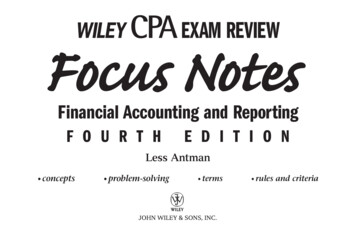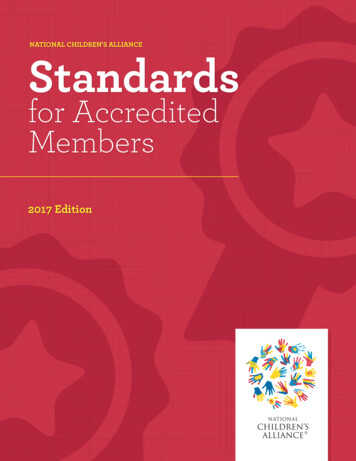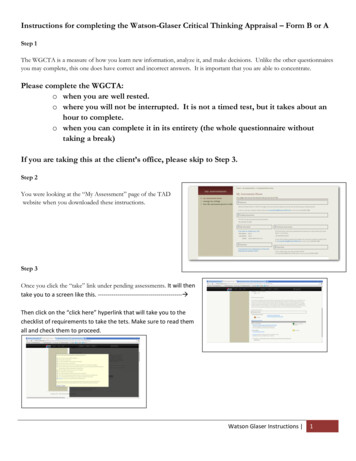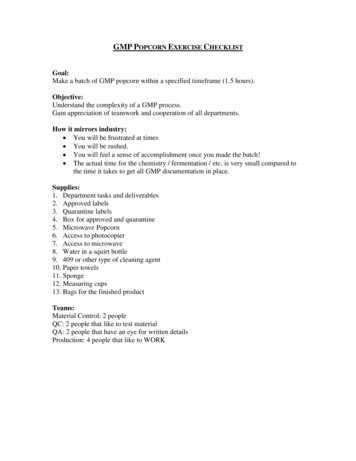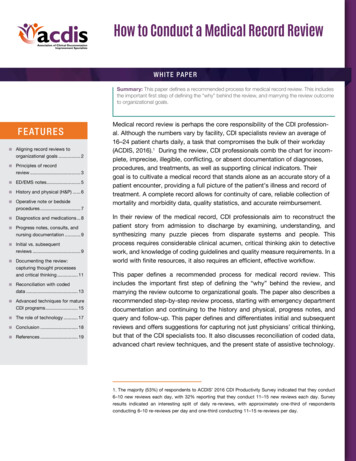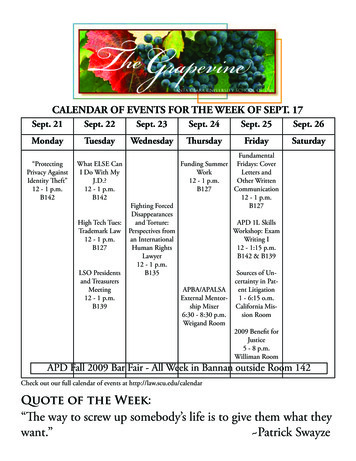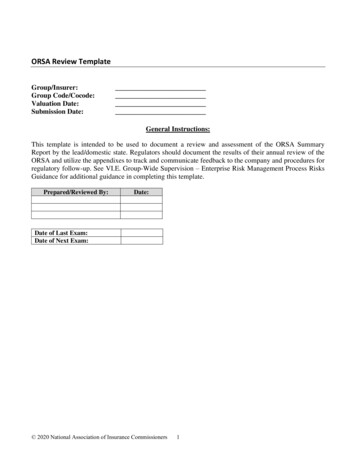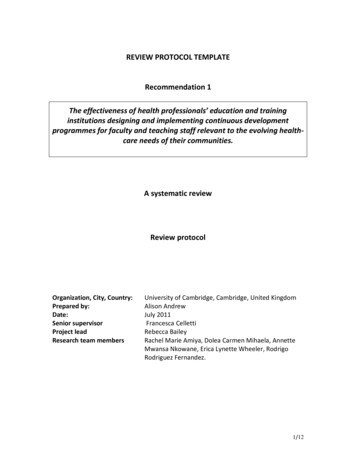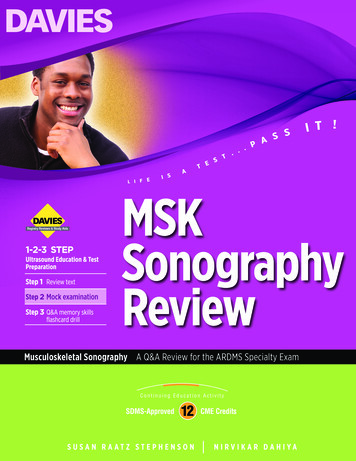
Transcription
DAVIESRegistry Reviews & Study AidsMSKSonographyReviewMusculoskeletal Sonography A Q&A Review for the ARDMS Specialty ExamContinuing Education ActivitySDMS-Approved12SUSAN RAATZ STEPHENSONCME CreditsN I R V I KA R DA H I YA
MusculoskeletalSonography ReviewA Q&A REVIEW FOR THE ARDMSMUSCULOSKELETAL SONOGRAPHER EXAM
MusculoskeletalSonography ReviewA Q&A REVIEW FOR THE ARDMSMUSCULOSKELETAL SONOGRAPHER EXAM2019Susan Raatz Stephenson, MS, MA Ed, RDMS, RVT, CIIPSiemens Medical Solutions USA, Inc.Salt Lake City, UtahNirvikar Dahiya, MD, FAIUM, FSRUDepartment of RadiologyMayo ClinicScottsdale, ArizonaDAVIESPUBLISHING
Copyright 2019 by Davies Publishing, Inc.DAVIESPUBLISHINGAll rights reserved. No part of this work may be reproduced, stored in a retrieval system,or transmitted in any form or by any means, electronic or mechanical, including photocopying, scanning, and recording, without prior written permission from the publisher.Davies Publishing, Inc.32 South Raymond AvenuePasadena, California 91105-1961Phone 626-792-3046Facsimile 626-792-5308e-mail ichael P. Davies, PublisherChristina J. Moose, Editorial DirectorCharlene Locke, Production ManagerJanet Heard, Operations ManagerSatori Design Group, Inc., DesignPrinted and bound in ChinaISBN 978-0-941022-67-5Library of Congress Cataloging-in-Publication DataNames: Stephenson, Susan Raatz, author. Dahiya, Nirvikar, author.Title: Musculoskeletal sonography review : a Q&A review for the ARDMSmusculoskeletal sonographer exam / Susan Raatz Stephenson, Nirvikar Dahiya.Description: Pasadena, California : Davies Publishing, Inc., 2019. Includesbibliographical references and index.Identifiers: LCCN 2018017863 ISBN 9780941022675 (pbk. : alk. paper)Subjects: MESH: Musculoskeletal System--diagnostic imaging Ultrasonography Musculoskeletal System--anatomy & histology Examination QuestionsClassification: LCC RC78.7.U4 NLM WE 18.2 DDC 616.07/543076--dc23 LC record available athttps://lccn.loc.gov/2018017863
ReviewersJoAnn Aichroth, RDMS, RVT, RMSKSSonographerThomas Jefferson University HospitalPhiladelphia, PennsylvaniaJohn Dlugosz, BS, RDMS, RMSKSClinical Coordinator, Division ofUltrasoundThomas Jefferson University HospitalPhiladelphia, PennsylvaniaBenjamin D. Levine, MDAssociate Professor of RadiologyDirector, Musculoskeletal InterventionsMusculoskeletal ImagingDepartment of Radiological SciencesUCLA David Geffen School of MedicineUCLA HealthLos Angeles, CaliforniaLauren Lown, BS, ARDMS, RVT, RMSKSTechnical Director, Vascular LabThomas Jefferson HospitalPhiladelphia, PennsylvaniaRoger Lown, BS, RDMS, RVT, RMSKSSonographerThomas Jefferson University HospitalPhiladelphia, PennsylvaniaJulia Michalek, BS, RDMS, RMSKSSonographer, Diagnostic Ultrasound,NM RadiologyDMS Clinical Instructor, NM AcademyNorthwestern MedicineChicago, IllinoisDaria Motamedi, MDDirector, Musculoskeletal UltrasoundAssistant Professor of Clinical RadiologyMusculoskeletal Imaging SectionDepartment of Radiology and BiomedicalImagingUCSF Medical CenterSan Francisco, CaliforniaDaniel Nissman, MD, MPH, MSEEDivision Chief, Musculoskeletal ImagingClinical Assistant Professor of RadiologyDepartment of RadiologyUNC School of MedicineChapel Hill, North CarolinaBenjamin E. Plotkin, MDAssistant Professor of RadiologyMusculoskeletal ImagingDepartment of Radiological SciencesUCLA David Geffen School of MedicineUCLA HealthLos Angeles, CaliforniaClaudia J. von Zamory, BA, RDMS, RVT,ARRT, CRTExecutive Program Director of UltrasoundTechnologyGurnick Academy of Medical ArtsSan Mateo, Californiav
PrefaceT IS MOCK EXAM is a question/answer/reference review of musculoskeletalHsonography for those candidates who plan to take the specialty examination forthe Registered Musculoskeletal Sonographer (RMSKS) credential, administeredby the American Registry for Diagnostic Medical Sonography (ARDMS). Physicianstaking the specialty exam for the Registered in Musculoskeletal (RMSK) sonographycredential, sponsored by ARDMS’s companion council, the Alliance for PhysicianCertification and Advancement (APCA), will likewise find that this mock exam offersan invaluable review of the basics, supplementing their preparation for the moreinterpretive and diagnosis-centered MSK exam. For both groups, this mock exam isalso considered a CME activity; an SDMS-approved CME quiz worth 12 credits will befound in Part 8 of this book.The mock exam is designed as an adjunct to your regular study and as a means ofhelping you determine your strengths and weaknesses so that you can study moreeffectively. It covers everything on the current ARDMS MSKS exam content outline,which you will find at the end of this book with cross-references to the questions in thismock exam.Facts about Musculoskeletal Sonography Review4 This mock exam covers the material on the ARDMS exam content outline in effect asof 2018. Readers are advised to check the ARDMS website, www.ardms.org, for thelatest updates. This mock exam itself is continuously updated and revised as necessary, and readers can check Davies’ website for the latest Study Alerts and otherproduct updates at 20.aspx.4 The Davies mock exam focuses exclusively on the MSKS specialty exam toensure thorough coverage of even the smallest subtopic on the exam. (For thosepreparing for the Sonography Principles and Instrumentation exam, see Davies’Ultrasound Physics Review: SPI Edition, available at www.daviespublishing.com.)4 We use the most current ARDMS content outline as a guideline for coverage. It is,in fact, our table of contents.4 This mock exam contains 571 questions, many of which are accompanied bysonographic and other images, anatomic illustrations, and schematics—more than200 in all.4 While otherwise in ARDMS exam format, this Davies mock exam makes deliberateand judicious use of multiple-choice items with five, not four, possible choices—thereby increasing both the difficulty of each question and the time needed tovii
viii Musculoskeletal Sonography Reviewanswer it. The point? To give you an educational tool that will exercise thoseneural pathways in more than one direction. Registry candidates who masterthese items at an average rate of 1 minute apiece will be exceptionally wellprepared for the actual exam.4 The answer key located in Part 7 contains not only the answers but also conciseexplanations that are abundant, clear, and authoritatively referenced for furtherstudy. We recommend that you have a copy of a standard musculoskeletalultrasound review text at your side when using this mock exam to study for theMSKS exam; you will see several of these referenced in the answer section andthe “Suggested Readings” in Part 9.4 This mock examination has been approved by the Society of Diagnostic MedicalSonography (SDMS) as a CME activity. A CME application form, quiz, and fullsubmission instructions are included in Part 8. Passing this quiz will qualify theapplicant for 12 CME credits. A modest administrative processing fee applies atthe time of submission, and more than one sonographer may submit this activityfor CME credit. These credits are accepted by ARDMS, APCA, the AmericanRegistry of Radiologic Technologists (ARRT), and other organizations towardmeeting their CME requirements. Some credentials carry stipulations regardingspecialty areas in which CME credits may be earned. Always check with theorganization that governs your credential(s). All the credits in this activity may beapplied to maintain the ARDMS RMSKS credential and the APCA RMSK credential.4 A list of “Suggested Readings” including current authoritative publications appearsin Part 9.4 The expanded ARDMS exam content outline, complete with all questions thatapply to specific clinical tasks, appears in Part 10. Under each task we haveindexed the question numbers in this mock exam that are related to that task, foryour convenience in targeting your study on specific exam topics. (To ensure thatyou are studying the most current MSKS examination outline, be sure to visit theARDMS website at www.ardms.org.)ARDMS Advanced Item Type (AIT) QuestionsAll the ARDMS exams now include Advanced Item Type (AIT) questions that assesspractical sonography instrumentation skills. For the MSKS specialty exam, these AITquestions include what ARDMS calls “Hotspot” questions. Hotspot items display animage with the question and ask you to indicate the correct answer by marking directlyon the image using your cursor; this type of question is called “advanced” because itinvolves a higher level of thinking and processing than you perform when answeringa conventional multiple-choice question. In Davies’ mock exam, similar questions areidentified as “AIT—Hotspot” questions. These items ask you to identify what an arrowin the image is pointing at or to indicate the label on an image that corresponds to thecorrect answer.
Musculoskeletal Sonography Review ixAnother type of AIT question, the Semi-Interactive Console (SIC) item, requiresthe examinee to use a semi-interactive console to correct a problem with the imagepresented. Currently these items do not appear on the MSKS exam, but as a bonusfeature we have identified such items as “AIT—SIC” questions.Finally, PACSim items—case-based Picture Archive and Communication Simulationquestions—are not included in this MSKS mock exam because currently this type ofquestion is specifically designed for and limited to the Ob/Gyn exam and the Physicianin Vascular Interpretation (PVI) exam, the latter under the jurisdiction of the Alliancefor Physician Certification and Advancement (APCA).How to Use This Mock ExamMusculoskeletal Sonography Review effectively simulates the content of the MSKSexam. Current ARDMS standards call for 170 multiple-choice questions to be answeredduring a three-hour period. That is, you will have an average time of approximately oneminute to answer each question. Timing your practice sessions according to the number of questions you need to finish will help you prepare for the pressure experiencedby MSKS candidates taking this exam. It also helps to ensure that your practice scoresaccurately reflect your strengths and weaknesses so that you can study more efficientlyin the limited time you are able to devote to preparation.IMPORTANT NOTE: Although many of our customers remark on similarities betweenour questions and those of the actual exam, do not be misled into thinking you shouldmemorize these questions and answers. They are here to give you practice, to teachyou things you may not know, and to reveal your strengths and weaknesses so thatyou know where to put your energy as you prepare for the exam. They also provide ameans of assessing your progress as you study.ARDMS test results are reported as a “scaled” score that ranges from a minimum of300 to a maximum of 700. A scaled score of 555 is the passing score—the “passpoint”or “cutoff score” for all ARDMS examinations. The scaled score is simply a conversionof the number of correct answers that also, in part, takes into account the difficulty ofa particular question. You can search on the Internet for the “Angoff scoring method”if you want to learn more about scaled scoring. Suffice it to say that it helps to ensurethe fairness of the exams.We include below and strongly recommend that you read Taking and Passing YourExam, by Don Ridgway, RVT, who offers useful tips and practical strategies for takingand passing the ARDMS examinations.Finally, you have not only our best wishes for success but also our admiration for takingthis big and important step in your career.Susan Raatz StephensonSusan Raatz StephensonMS, MA Ed, RDMS, RVT, CIIPNirvikar DahiyaNirvikar DahiyaMD, FAIUM, FSRU
Taking and Passing Your Examby Don Ridgway, RVT*Preparing for Your Exam . . .Study. And then study some more. Knowing your stuff is the most important factorin your success. Start early, set a regular study schedule, and stick to it. Make yourschedule specific so you know exactly what to study on a particular day. Write it down.Establish realistic goals so that you don’t build a mountain you can’t climb.As to what you study, don’t just read aimlessly. Focus your efforts on what youneed to know. Rely on a core group of dependable references, referring to others asnecessary to firm up your understanding of specific topics. Let the ARDMS exam outlineguide you. And use different but complementary study methods—texts, flashcards, andmock exams—to exercise those neural pathways.Ease down on studying the week before. Wind down, reduce stress, buildconfidence, and rest up. Don’t cram! And no studying the night before. You had yourchance. Watch a movie, relax, go to bed early, and sleep well.Organize your things the night before. Lay out comfortable clothes (including asweater or sweatshirt in case the testing center is cold), your photo ID, car and housekeys, glasses, prescriptions, directions to the test center, and any other personalitems you might need. Remember that the only thing you can take into the testingroom is you—there will be lockers for your personal items. Read about necessarydocumentation and examination admission compliance requirements for your exam atwww.ardms.org. Be prepared!The Day of Your Exam . . .Eat lightly. You do not want to fall asleep during the exam. Go easy on the coffee ortea so your bladder doesn’t distract you halfway through the exam.Arrive early. Plan to arrive at the test center early, especially if you haven’t beenthere before. Take directions, including the telephone number of the testing center incase you have to make contact en route. You don’t need a wrong-offramp adventure.Be confident. As you wait for the exam to begin, smile, lift both hands, wave themtoward yourself, and say, “Bring it on.”*Don Ridgway is the author of Introduction to Vascular Scanning: A Guide for the Complete Beginner and editor ofVascular Technology Review. He is Professor Emeritus at Grossmont College in El Cajon, California.x
Musculoskeletal Sonography Review xiDuring the Exam . . .Read each question twice before answering. Guess how easy it is to get one wordwrong and misunderstand the whole question!Try to answer the question before looking at the choices. Formulating an answerbefore peeking at the possibilities minimizes the distraction of the incorrect answerchoices, which in the test-making business are called—guess what?—distractors.Knock off the easy ones first. First answer the questions you feel good about. Thengo back for the more difficult items. Next, attack the really tough ones. Taking notes onlong or tricky questions often can jog your memory or put the question in new light. Forquestions you just cannot answer with certainty, eliminate the obviously wrong answerchoices and then guess.Guessing. Passing the exam depends on the number of correct answers you make.Because unanswered questions are counted as incorrect, it makes sense to guess whenall else fails. The ARDMS itself advises that it is to the candidate’s advantage to answerall questions. Guessing alone improves your chances of scoring a point from 0 (for anunanswered question) to 25% (for randomly picking one of four possible answers).Eliminating answer choices you know or suspect are wrong further improves your oddsof success. By using your knowledge and skill to eliminate two of the four answerchoices before guessing, for example, you increase your odds of scoring a point to 50%.Pace yourself; watch the time. Work methodically and quickly to answer those youknow, and make your best guesses at the gnarly ones. Leave no question unanswered.Don’t despair 50 minutes into the exam. At some point you may feel that thingsjust aren’t going well. Take 10 seconds to breathe deeply—in for a count of five, out fora count of five. Relax. Recall that you need to get only about three out of four answerscorrect to pass. If you’ve prepared reasonably well, a passing score is attainable even ifyou feel sweat running down your back.Taking the Exam on Computer . . .Some candidates express concern about taking the registry exam on a computer. Mostfolks find this to be pretty easy; some find it offputting, at least in prospect. But thecomputerized exams are quite convenient: You know whether or not you passed beforeyou leave the testing center (compare that to waiting weeks and even months, as usedto be the case), and if you happen not to pass the first time, you can usually take itagain after a couple months. Another good point: The illustrations are said to be cleareron computer than in the booklets at a Scantron-type exam.Taking the test by computer is not complicated. The test center even has a tutorial tobe sure you know what you need to do. You sit in a carrel with a computer and answerthe multiple-choice questions by pointing and clicking with a mouse. There is a clockon the display letting you know how much time is left. Use it to pace yourself. A whiteboard (today’s equivalent of scratch paper) is available upon request, and it’s a goodidea to have one at your side for notes.
xii Musculoskeletal Sonography ReviewYou can mark questions for answering later. A display shows which questions havenot been answered so you can return to them. When you have finished, you click on“DONE,” and you find out immediately whether you passed.It’s nothing to be afraid of. The principles are the same as those for any exam. Bemethodical and keep breathing.Summary . . .Preparing for the exam:4 Study.4 Use flashcards.4 Join a study group.4 Wind down a week before.4 Don’t cram.4 Relax!The day of your exam:4 Eat lightly; avoid too much caffeine.4 Arrive early.4 Take a sweater.4 Be confident!During the exam:4 Read each question twice.4 Answer the question before looking at the answer choices.4 Answer the easy ones first.4 Guess when necessary.4 Pace yourself.4 Don’t despair.Taking the exam on computer:4 Just point and click.4 Take notes.4 Mark and return to the hard questions.4 Use the onscreen clock to pace yourself.4 Be methodical.4 Breathe!
ContentsReviewers vPreface viiTaking and Passing Your Exam xColor Plates xviiPART 1Anatomy and Physiology 1General anatomy and physiology 2Abdominal wall 6Perform general ultrasound of the muscles and fasciae of theabdominal wallAnkle and foot 8Perform general ultrasound of the bones, bursae, fat pads, and jointsof the ankle and footPerform general ultrasound of the fasciae, ligaments, muscles,retinaculum, and tendons of the ankle and footPerform general ultrasound of the neurovascular system of the ankleand footElbow 19Perform general ultrasound of the bones, bursae, fat pad, joints, andligaments of the elbowPerform general ultrasound of the muscles and tendons of the elbowPerform general ultrasound of the neurovascular system of the elbowHand and wrist 25Perform general ultrasound of the bones and joints of the hand andwristPerform general ultrasound of the fasciae, muscles, tendons,retinaculum, pulleys, and ligaments of the hand and wristPerform general ultrasound of the neurovascular system of the handand wristxiii
xiv Musculoskeletal Sonography ReviewHip, groin, and pelvis 34Perform general ultrasound of the bones, bursae, cartilage, tendons,and joints of the hip, groin, and pelvisPerform general ultrasound of the muscles of the hip, groin, and pelvisPerform general ultrasound of the lymphatic and neurovascular systemof the hip, groin, and pelvisPerform general ultrasound of the infant hipKnee 46Perform general ultrasound of the bones, bursae, cartilage, and jointsof the kneePerform general ultrasound of the muscles, tendons, retinaculum, andligaments of the kneePerform general ultrasound of the neurovascular system of the kneeShoulder 60Perform general ultrasound of the bones, bursae, cartilage, joints, andligaments of the shoulderPerform general ultrasound of the muscles and tendons of the shoulderPerform general ultrasound of the neurovascular system of theshoulderSoft tissue 71Evaluate soft tissuePART 2General Sonographic Pathology 73Abnormal physiology 74Evaluate tendon pathology, calcifications, and tearsEvaluate massesEvaluate fluid collectionsEvaluate cystic structuresEvaluate herniasEvaluate soft-tissue pathologyEvaluate muscle pathology and tearsEvaluate joint effusionsEvaluate ligament pathology and tearsEvaluate for foreign bodyEvaluate subcutaneous abnormalitiesEvaluate infections
Musculoskeletal Sonography Review Evaluate synovitis and tenosynovitisEvaluate synovial proliferationEvaluate neuromasEvaluate nerve pathology and entrapmentEvaluate for gas within the soft tissueEvaluate bone pathology and erosionEvaluate fracturesEvaluate crystal depositsEvaluate joint laxity/altered functionPART 3Integration of Data 119Incorporate outside data 120Correlate findings with clinical presentationCorrelate information with previous testsPerform anatomic assessment during dynamic scanningAssess postsurgical anatomy and hardwareDifferentiate pediatric from adult anatomyReport results 136Report impression of the examSerial studies 138Follow course of disease with serial ultrasound examsEvaluate cartilage pathologyPART 4Protocols 141Clinical standards and guidelines 142Gather clinical history of the patientPosition patient and ultrasound machineDocument and confirm proceduresRecognize the limitations of the prescribed examination based on thefindingsFollow ultrasound imaging protocols for musculoskeletal-related studiesVerify the appropriateness of the orderSet up the equipment and the examination roomAssess the physical condition of the patient, focusing on the area to beexaminedxv
xvi Musculoskeletal Sonography ReviewCommunicate with the patientCommunicate ultrasound findingsGenerate an initial plan for the examinationMeasurement techniques 158Perform measurementsPART 5Treatment 165Interventional procedures 166Maintain aseptic techniquesAssist/support during guidance for interventional proceduresSonographer role in procedures 173Recognize ultrasound findings that require immediate actionFollow postprocedural protocolsCreate incident reports when requiredPART 6Physical Principles and Instrumentation 177TransducersStandoff padsArtifactsBioeffectsCompoundingDynamic range/compressionExtended field of viewGainHarmonicsPersistence/frame averagingResolutionSpeed errorsTissue phantomsPART 7Answers, Explanations, and References 193PART 8Application for CME Credit 425PART 9Suggested Readings 463PART 10ARDMS Exam Content Outline Tasks Cross-Referencedto Mock Exam Questions 465
32 Musculoskeletal Sonography Review104. Identify the structures located within Guyon’s canal.A. Radial artery, vein, and nerveB. Musculoskeletal nerve, axillary artery, and veinC. Cephalic vein and extensor wrist tendonsD. Ulnar artery, vein, and nerveE. Radial artery, median nerve, and flexor digitorumtendons105. This transverse image was taken on the volar side ofthe wrist at the distal crease. Identify the structure(s)indicated by the arrows.A. Hamate, capitate, and trapezoid bonesB. Tendons of the digitorum superficialisC. Tendons of the digitorum profundusD. Radial and ulnar vesselsE. Flexor retinaculumAIT—Hotspot106. This image was obtained in the transverse plane on thevolar side of the wrist at the level of the carpal tunnel.What structure lies in the circle?
Musculoskeletal Sonography Review 33A. Flexor tendon sheathB. Flexor retinaculumC. Guyon’s canalD. Median nerveE. Pisiform boneAIT—Hotspot107. The median nerve may have a bifid appearance in thetransverse image of the wrist. What percentage ofpeople have this nerve variation?A. 2%–3%B. 10%–15%C. 45%–50%D. 50%–60%E. About 75%108. This transverse image was taken at the level of thecarpal tunnel. Identify the structure indicated by thearrows.A. Persistent median arteryB. Complex ganglionC. Retinaculum partial tearD. Bifid median nerveE. Thenar muscle groupAIT—Hotspot
34 Musculoskeletal Sonography ReviewHip, Groin, and PelvisPerform general ultrasound of the bones, bursae, cartilage,tendons, and joints of the hip, groin, and pelvisPerform general ultrasound of the muscles of the hip,groin, and pelvisPerform general ultrasound of the lymphatic and neurovascular system of the hip, groin, and pelvisPerform general ultrasound of the infant hip109. When imaging the normal anterior hip in the transverseplane, where will you see the iliopsoas tendon located inrelation to the femoral head?A. LateralB. AnteriorC. PosteriorD. SuperiorE. Cephalad110. Imaging of the lateral hip relies on bony landmarks toconfirm the correct location and anatomic structures.In the transverse plane, what is the key landmark forvisualizing the gluteus medius and minimus insertions?A. Trochanteric posterior facetB. Trochanteric fossa at the neckC. Echogenic articular capsuleD. Apex of the greater trochanterE. Acetabular fibrocartilaginous margin111. Tendons and ligaments have a characteristicsonographic appearance. Which of the followingdescribes the normal echogenicity of the iliopsoastendon at its distal insertion?A. IsoechoicB. AnechoicC. HypoechoicD. HeterogeneousE. Echogenic
Musculoskeletal Sonography Review 35112. The two major bursae of the hip are the greatertrochanteric bursa and the iliopsoas bursa. Whereis the iliopsoas bursa located?A. Posterior to the greater trochanter of the femurB. Medial to the ischial tuberosity of the pelvisC. Inferior to the ischiogluteal and gluteus medius bursaeD. Between the femoral head and the iliopsoas muscle/tendonE. Central to the vastus lateralis muscle113. Scanning approach is important when imaging the hiptendons. Identify the correct transducer placement forimaging the gluteus medius and gluteus minimus distalattachments on the trochanter.A. AnteriorB. PosteriorC. SuperiorD. LateralE. Caudad114. What structure is indicated by the arrow in this schematic?Source: Copyright Beth Ohara / Wikimedia Commons / CC-BY-SA-3.0.Available at http://en.wikipedia.org/wiki/File: Anterior Hip Muscles 2.PNG.A. Iliotibial tractB. Tensor fasciae latae originC. Iliopsoas tendon insertionD. Adductor longus aponeurosisE. Pectineus insertionAIT—Hotspot
36 Musculoskeletal Sonography Review115. This diagram mimics a coronal view when you areimaging the hip while the patient is on his side. Identifythe structure labeled A.This image refers toquestions 115–120.BACDFESource: Adapted from Connell DA, Bass C, Sykes CA, et al: Sonographicevaluation of gluteus medius and minimus tendinopathy. Eur Radiol13:1339–1347, 2003, fig 1a. Reprinted with permission.A. Tensor fasciae lataeB. Subgluteus maximus bursaC. Gluteus minimus tendonD. Subgluteus medius bursaE. Subgluteus minimus bursaF. Gluteus medius tendonAIT—Hotspot116. Refer to the image in question 115. Identify thestructure labeled B.A. Tensor fasciae lataeB. Subgluteus maximus bursaC. Gluteus minimus tendonD. Subgluteus medius bursaE. Subgluteus minimus bursaF. Gluteus medius tendonAIT—Hotspot117. Refer to the image in question 115. Identify thestructure labeled C.A. Tensor fasciae lataeB. Subgluteus maximus bursaC. Gluteus minimus tendonD. Subgluteus medius bursaE. Subgluteus minimus bursaF. Gluteus medius tendonAIT—Hotspot
Musculoskeletal Sonography Review 37118. Refer to the image in question 115. Identify thestructure labeled D.A. Tensor fasciae lataeB. Subgluteus maximus bursaC. Gluteus minimus tendonD. Subgluteus medius bursaE. Subgluteus minimus bursaF. Gluteus medius tendonAIT—Hotspot119. Refer to the image in question 115. Identify thestructure labeled E.A. Tensor fasciae lataeB. Subgluteus maximus bursaC. Gluteus minimus tendonD. Subgluteus medius bursaE. Subgluteus minimus bursaF. Gluteus medius tendonAIT—Hotspot120. Refer to the image in question 115. Identify thestructure labeled F.A. Tensor fasciae lataeB. Subgluteus maximus bursaC. Gluteus minimus tendonD. Subgluteus medius bursaE. Subgluteus minimus bursaF. Gluteus medius tendonAIT—Hotspot121. During the sonographic examination it is important toimage attachment sites for muscles and tendons. Thegluteus minimus and medius muscles begin (originate)at the external iliac fossa. Where do these musclesterminate (insert)?A. Posterior sacrococcygeal lineB. Greater trochanter of the femurC. Ischial tuberosityD. Medial surface of the tibiaE. Linea aspera
PART 7Answers, Explanations,and ReferencesAnatomy and physiologyGeneral sonographic pathologyIntegration of dataProtocolsTreatmentPhysical principles and instrumentation193
236 Musculoskeletal Sonography Review103. E. Relatively immobile structure hypoechoic to muscle.The relatively immobile, cordlike, tubular median nerve ishypoechoic to the tendon and muscle when imaged in thelongitudinal plane. The transverse appearance is a hypoechoicstructure with internal fibers and a fascicular pattern.ANSWERS4Raatz Stephenson S: The musculoskeletal system. In Hagen-Ansert SL(ed): Textbook of Diagnostic Sonography, 7th edition. St. Louis, ElsevierMosby, 2012, p 636.104. D. Ulnar artery, vein, and nerve.The ulnar artery, vein, and nerve are contained within Guyon’scanal, located on the lateral portion of the wrist. The radialartery, vein, and nerve are located on the thumb side of thewrist superficial to the cephalic vein and the first extensorwrist compartment tendons. The carpal tunnel contains themedian nerve, radial artery, flexor carpi radialis, and palmarislongus and flexor digitorum tendons.4Jacobson JA: Fundamentals of Musculoskeletal Ultrasound, 2nd edition.Philadelphia, Elsevier Saunders, 2013, pp 119–121.4Jacobson JA: Fundamentals of Musculoskeletal Ultrasound, 3rd edition.Philadelphia, Elsevier, 2018, p 178.105. E. Flexor retinaculum.The flexor retinaculum (arrows) provides the anterior borderof the carpal tunnel. Within the carpal tunnel are the roundedfinger flexor tendons (digitorum superficialis and profundus)and median nerve. Posterior to the carpal tunnel are thecarpal b
Ultrasound Physics Review: SPI Edition, available at www.daviespublishing.com.) 4 We use the most current ARDMS content outline as a guideline for coverage. It is, in fact, our table of contents. 4 This mock exam contains 571 questions, many of which are accompanied by sonographic and other


